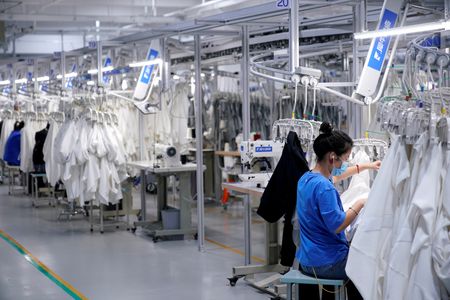BEIJING (Reuters) – China’s factory activity contracted at a sharper pace in September as strict COVID lockdowns disrupted production and dampened sales, a private sector survey showed on Friday.
Weakening global demand for Chinese goods also weighed heavily on the manufacturing sector, with new export orders shrinking at the fastest pace in four months.
The Caixin/Markit manufacturing purchasing managers’ index (PMI) fell more than expected to 48.1 in September from 49.5 in August, below the 50-point which marks separates growth from contraction on a monthly basis.
Analysts in a Reuters poll had expected the reading would be unchanged from August.
Surveyed firms attributed the COVID-19 epidemic as the greatest impact factor, the private survey said.
“Manufacturing supply and demand contracted simultaneously. Although the COVID situation improved in Hainan province, the severity of outbreaks worsened in many other areas and containment measures limited the supply and demand in manufacturing,” said Wang Zhe, senior economist at Caixin Insight Group.
Manufacturers reported a sharper drop in sales, with sub-indexes for total new orders and new export orders both contracting for the second straight month in September.
In response, firms cut production for the first time in four months and shed jobs for the sixth straight month to reduce costs, adding to worries about the weak labour market.
Manufacturers also scaled back their purchasing activity, with the sub-index of quantity of purchases falling for the second month in September, due to fewer new orders and efforts to reduce overall stock levels.
One bright spot was a fall in input costs for the second month in a row as prices of raw materials declined due to softer demand.
In order to boost sales, producers looked to pass on some cost savings to customers, which led to the sub-index of output prices dropping at the fastest pace since December 2015.
“At present, major problems in the economy are insufficient employment, sluggish demand, and unstable expectations. In view of this, policy implementation should focus on promoting employment, granting subsidies, boosting demand, and fostering market confidence by sending policy signals,” said Wang.
China narrowly escaped an economic contraction in the June quarter, weighed by a deepening property slump, slowing consumption and strict COVID-19 restrictions. Sporadic virus flare-ups again weighed on activity in late August and early September.
With few signs China will significantly ease zero-COVID soon, many analysts expect the economy to grow by just 3% this year, which would be the slowest since 1976, excluding the 2.2% expansion during the initial COVID hit in 2020.
Nomura has slashed its forecast on China’s annual GDP growth to 2.7% for 2022.
(Reporting by Liangping Gao and Ryan Woo; Editing by Kim Coghill)





